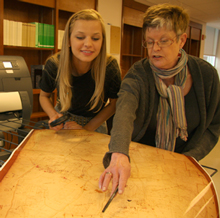Purgatory...with a capital 'P'
Prehistoric megalithic dolmens and menhirs dot the landscape of Dénezé-sous-Doué. At certain times of the year, the fields reveal lines that are congruent with boundaries of the narrow farm plots shown on 200-year-old maps.
 It's a place that has been continuously
populated for millennia. Barbara Watkinson says that even the place
names in
this part of France have changed very little from medieval times to the
present. Watkinson brings together a collection of documents including
11th-Century monastic land records, Napoleon Bonaparte's tax maps,
aerial
photographs, satellite imagery and modern maps to chart and explain the
transformation of the landscape in this particular area of western
France.
It's a place that has been continuously
populated for millennia. Barbara Watkinson says that even the place
names in
this part of France have changed very little from medieval times to the
present. Watkinson brings together a collection of documents including
11th-Century monastic land records, Napoleon Bonaparte's tax maps,
aerial
photographs, satellite imagery and modern maps to chart and explain the
transformation of the landscape in this particular area of western
France.
Watkinson, an associate professor in William & Mary's art and art history department, enlisted the Center for Geospatial Analysis for help in "stitching together" the various media using various GIS techniques to reveal historic patterns of land ownership in the melded data.
Lessons in data stitchery
At William & Mary's CGA, Stuart Hamilton taught Watkinson and her student, Cassandra Prena '12, how to stitch their data, using rubbersheeting and other relevant GIS techniques. They're focusing their research on the transfer of property from lay to ecclesiastic ownership during the 11th and 12th Centuries. Watkinson explained that landowners were regularly prompted to donate real estate to religious authorities in exchange for prayers to relieve the suffering of dead family members in the afterlife.
"Purgatory is where you go to be purified of your earthly sins. About the middle of the 12th Century, purgatory started to be spelled with a capital ‘P'. To them, it was a real place," Watkinson explained. "Monks wrote and talked a lot about purgatorial torments. They used it as a lever to motivate people to make donations to get the souls of their parents and ancestors-and themselves-transferred out of the tormenting waiting place to the nice waiting place. There are all these stories about spirits of the dead returning to their children, telling them all these horrible details about their suffering and pleading for them to go to the monks and follow through on a gift of a farm or even a church."
Even though Watkinson had spatial data from several eras, her work with the CGA revealed that her project required a greater degree of accuracy. To this end, Watkinson and Prena walked the fields and roads of Dénezé-sous-Doué about a year ago. Armed with a notebook, a handheld GPS plotter and practical advice from Hamilton, professor and student nailed down the x, y and z coordinates of the Dénezé commune.
"Stu told us to use something pretty immutable to make our plots," Watkinson said, "not necessarily the kinds of things we're interested in, but churches and roads. Their locations have hardly changed over hundreds of years. What was a main road in the Napoleonic era is still there, but now it's a dirt path."
Sowing seeds of resentment
The redistribution of wealth in medieval France has enormous cultural and historical significance, Watkinson said. Through the lever of purgatorial paranoia, churches and abbeys gained more than agricultural land, accumulating mills, tanneries and other industrial properties-including, Watkinson says, "related indentured workers, the kinds of people we came to call serfs." And of course, abbots, bishops and religious orders grew richer and more powerful. Watkinson points out that while the church was reaping the benefits of the landed gentry's concern for their ancestors' afterlife, it was also sowing the seeds of resentment that grew into the social and political upheaval of the French Revolution.
"The church became even more hated than, perhaps, the monarchy," she said.
By Joseph McClain